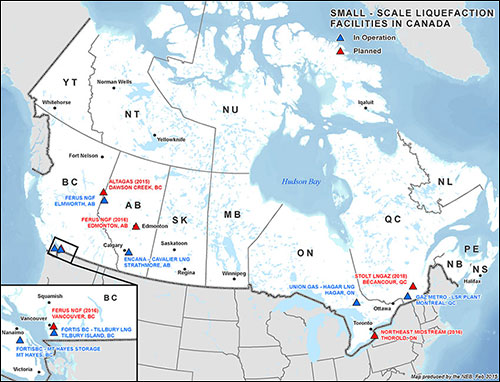Market Snapshot: Small-Scale LNG Plants Strategically Located to Meet Emerging Domestic LNG Demand
Release date: 2015-02-24
Liquefied natural gas, or LNG, can be used to generate electricity, heat buildings, power drilling rigs, and fuel ferries and marine vehicles. A main impediment to using LNG in Canada has been the lack of liquefaction infrastructure. Without nearby plants to liquefy natural gas, LNG must be shipped via truck over long distances, increasing the cost for consumers. Recent estimates (page 1340) suggest that trucking LNG 1000 km can increase its cost by $1.88 – 3.10 per million British thermal units.
The recent and proposed construction and expansions of small-scale liquefaction facilities would decrease trucking distances for many prospective adopters of LNG as a fuel.
Small-scale Liquefaction Facilities in Canada
Figure Sources and Description
Sources: Various press releases
Description: This map shows the location of in operation and planned small-scale liquefaction facilities in Canada. In operation facilities include FortisBC's Mt Hayes Storage on Vancouver Island and Tilbury LNG on Tilbury Island near Vancouver, Ferus NGF in northwestern Alberta, Encana's Cavalier LNG east of Calgary, Union Gas' Hagar LNG near Sudbury, Ontario, and Gaz Metro's LSR plant near Montreal. Planned facilities include Ferus NGF facilities near Vancouver and Edmonton (both 2016), Altagas' plant in northeast British Columbia (2015), Northeast Midstream's facility south of Toronto (2016) and Stolt LNGaz, north of Montreal (2018).
Examples of LNG usage that will utilize these small-scale liquefaction facilities are listed below. The list is not exhaustive but provides a sampling of the various facilities.
Freight Vehicles: Canadian liquefaction facilities servicing freight vehicles are generally located near Canadian freight corridors. For example, the proposed facilities by Ferus NGF in both Edmonton and Vancouver are placed along freight corridors and will fuel ENN Canada’s LNG refueling stations in both cities, while GazMetro currently supplies five refueling stations along the 401 highway.
Remote Communities: The Dawson Creek and Elmworth facilities would provide a closer source of LNG for the Northern Territories, which are starting to use LNG to displace diesel-powered electricity generation. They are also located in the heart of the Montney natural gas formation, where LNG could be used to power drilling rigs. Gaz Metro and Stolt LNGaz are planning to ship LNG from their facilities to remote customers in northeastern Canada. FortisBC also had LNG trailer loading capabilities installed onto its Mt Hayes facility in January 2015, enabling it to service LNG demands on Vancouver Island.
Marine: Coastal facilities can be used to fuel LNG-powered ferries and marine vessels, as illustrated by FortisBC’s recent agreement to supply up to 300,000 gigajoules of LNG a year to BC Ferries for the next 10 years.
Exports: Hawaiian Electric has agreed to import LNG from FortisBC’s Tilbury Island facility for 15 years starting in 2017 and Northeast Midstream can use its planned Thorold facility to service various emerging LNG demands in the northeastern United States.
This snapshot builds on one topic covered in the Board’s recently released report Canadian Energy Dynamics: Review of 2014. The Report describes many important developments witnessed in Canadian energy markets in 2014, while providing useful information and statistics.
- Date modified:

